Android 14 introduce fantastiche funzionalità e API per gli sviluppatori. Le seguenti guide ti aiutano a scoprire le funzionalità delle tue app e a iniziare a utilizzare le API correlate.
Per un elenco dettagliato delle API aggiunte, modificate e rimosse, leggi il report diff API. Per informazioni dettagliate sulle API aggiunte, visita la documentazione di riferimento delle API Android. Per Android 14, cerca le API aggiunte nel livello API 34. Per scoprire le aree in cui le modifiche alla piattaforma potrebbero influire sulle tue app, consulta le modifiche al comportamento di Android 14 per le app che hanno come target Android 14 e per tutte le app.
Internazionalizzazione
Lingua preferita nelle app
Android 14 espande le funzionalità per lingua per app introdotte in Android 13 (livello API 33) con le seguenti funzionalità aggiuntive:
Genera automaticamente il
localeConfigdi un'app: a partire da Android Studio Giraffe Canary 7 e AGP 8.1.0-alpha07, puoi configurare l'app in modo che supporti automaticamente le preferenze per le lingue per app. In base alle risorse del progetto, il plug-in Android per Gradle genera il fileLocaleConfige aggiunge un riferimento al file manifest finale, quindi non devi più creare o aggiornare il file manualmente. AGP utilizza le risorse nelle cartelleresdei moduli dell'app e eventuali dipendenze dei moduli della libreria per determinare le lingue da includere nel fileLocaleConfig.Aggiornamenti dinamici per il
localeConfigdi un'app: utilizza i metodisetOverrideLocaleConfig()egetOverrideLocaleConfig()inLocaleManagerper aggiornare dinamicamente l'elenco delle lingue supportate della tua app nelle impostazioni di sistema del dispositivo. Utilizza questa flessibilità per personalizzare l'elenco delle lingue supportate per regione, eseguire esperimenti A/B o fornire un elenco aggiornato delle impostazioni internazionali se la tua app utilizza i push lato server per la localizzazione.Visibilità della lingua dell'app per gli editor di metodi di immissione (IME): gli IME possono utilizzare il metodo
getApplicationLocales()per controllare la lingua dell'app corrente e associare la lingua dell'IME a quella lingua.
API Grammatical Inflection
Tre miliardi di persone parlano lingue con genere: lingue in cui le categorie grammaticali, come nomi, verbi, aggettivi e preposizioni, si declinano in base al genere delle persone e degli oggetti di cui parli o a cui ti riferisci. Tradizionalmente, molte lingue con genere grammaticale utilizzano il genere grammaticale maschile come genere predefinito o generico.
Rivolgersi agli utenti con il genere grammaticale sbagliato, ad esempio alle donne con il genere grammaticale maschile, può influire negativamente sul loro rendimento e sul loro atteggiamento. Al contrario, un'interfaccia utente con un linguaggio che riflette correttamente il genere grammaticale dell'utente può migliorare il coinvolgimento dell'utente e offrire un'esperienza utente più personalizzata e dal suono naturale.
To help you build a user-centric UI for gendered languages, Android 14 introduces the Grammatical Inflection API, which lets you add support for grammatical gender without refactoring your app.
Preferenze regionali
Le preferenze regionali consentono agli utenti di personalizzare le unità di misura della temperatura, il primo giorno della settimana e i sistemi di numerazione. Un europeo che vive negli Stati Uniti potrebbe preferire che le unità di misura della temperatura siano in gradi Celsius anziché Fahrenheit e che le app trattino il lunedì come inizio della settimana anziché la domenica, che è il valore predefinito negli Stati Uniti.
I nuovi menu Impostazioni Android per queste preferenze offrono agli utenti un punto di riferimento rilevabile e centralizzato per modificare le preferenze delle app. Queste preferenze rimangono invariate anche durante il backup e il ripristino. Diverse API e
come intenti,
getTemperatureUnit
e
getFirstDayOfWeek—
Concedi alla tua app l'accesso in lettura alle preferenze dell'utente, in modo che possa regolare il modo in cui
visualizza le informazioni. Puoi anche registrare un
BroadcastReceiver attivo
ACTION_LOCALE_CHANGED
per gestire le modifiche alla configurazione delle impostazioni internazionali quando cambiano le preferenze regionali.
Per trovare queste impostazioni, apri l'app Impostazioni e seleziona Sistema > Lingue e input > Preferenze regionali.
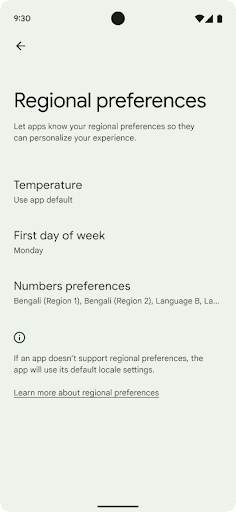
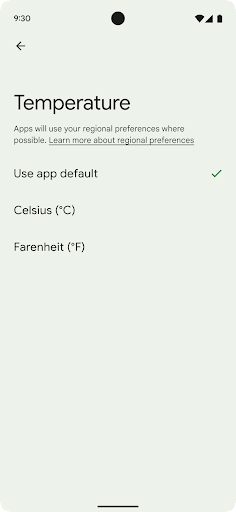
Accessibilità
Ridimensionamento non lineare dei caratteri fino al 200%
A partire da Android 14, il sistema supporta il ridimensionamento dei caratteri fino al 200%, offrendo agli utenti opzioni di accessibilità aggiuntive.
Per evitare che gli elementi di testo di grandi dimensioni sullo schermo vengano ridimensionati in modo eccessivo, il sistema applica una curva di ridimensionamento non lineare. Questa strategia di ridimensionamento fa sì che il testo grande non venga ridimensionato alla stessa velocità del testo più piccolo. Il ridimensionamento non lineare dei caratteri consente di preservare la gerarchia proporzionale tra elementi di dimensioni diverse, riducendo i problemi di ridimensionamento lineare del testo a livelli elevati (ad esempio testo troncato o testo che diventa più difficile da leggere a causa di dimensioni del display estremamente grandi).
Testare l'app con il ridimensionamento non lineare dei caratteri
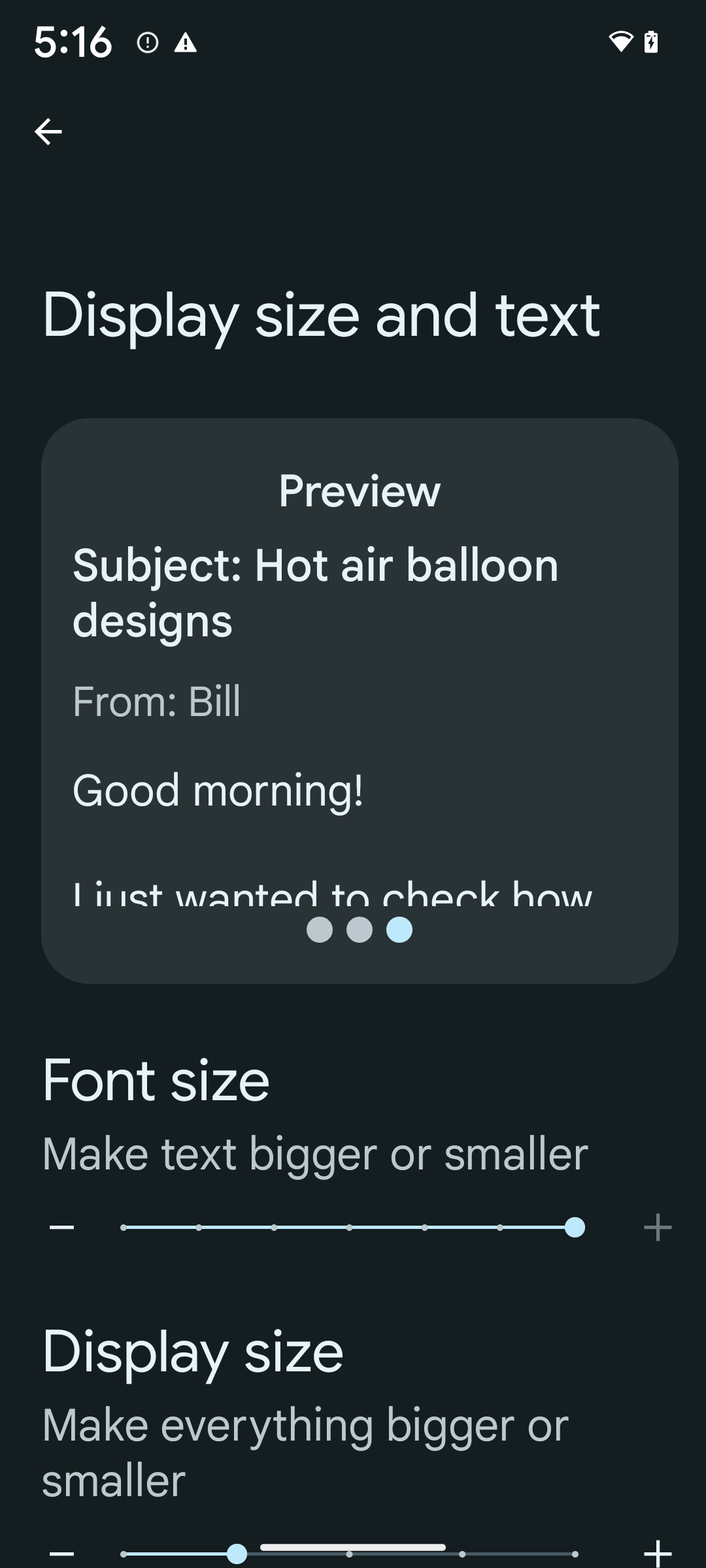
Se utilizzi già le unità di pixel scalabili (sp) per definire le dimensioni del testo, queste opzioni aggiuntive e i miglioramenti del ridimensionamento vengono applicati automaticamente al testo della tua app. Tuttavia, devi comunque eseguire test dell'interfaccia utente con le dimensioni del carattere massime abilitate (200%) per assicurarti che la tua app applichi correttamente le dimensioni del carattere e possa ospitare dimensioni del carattere più grandi senza influire sull'usabilità.
Per attivare le dimensioni del carattere al 200%:
- Apri l'app Impostazioni e vai a Accessibilità > Dimensioni visualizzazione e testo.
- Per l'opzione Dimensioni carattere, tocca l'icona Più (+) finché non viene attivata l'impostazione delle dimensioni massime del carattere, come mostrato nell'immagine che accompagna questa sezione.
Utilizzare unità di pixel scalati (sp) per le dimensioni del testo
Ricorda di specificare sempre le dimensioni del testo in unità sp. Quando la tua app utilizza le unità sp, Android può applicare la dimensione del testo preferita dall'utente e ridimensionarla in modo appropriato.
Non utilizzare unità sp per la spaziatura interna o definire le altezze delle visualizzazioni presupponendo una spaziatura interna implicita: con il ridimensionamento non lineare dei caratteri, le dimensioni sp potrebbero non essere proporzionali, quindi 4 sp + 20 sp potrebbero non essere uguali a 24 sp.
Convertire le unità di pixel scalabili (sp)
Utilizza TypedValue.applyDimension() per convertire le unità sp in pixel e TypedValue.deriveDimension() per convertire i pixel in sp. Questi metodi applicano automaticamente la curva di scalabilità non lineare appropriata.
Evita di codificare le equazioni utilizzando
Configuration.fontScale o
DisplayMetrics.scaledDensity. Poiché il ridimensionamento dei caratteri non è lineare, il campo scaledDensity non è più preciso. Il campo fontScale
deve essere utilizzato solo a scopo informativo perché i caratteri non vengono più
scalati con un singolo valore scalare.
Utilizza le unità sp per lineHeight
Definisci sempre android:lineHeight utilizzando le unità sp anziché dp, in modo che l'altezza della riga venga scalata insieme al testo. In caso contrario, se il testo
è in sp, ma il lineHeight è in dp o px, non viene scalato e appare compresso.
TextView corregge automaticamente lineHeight in modo che le proporzioni che intendi utilizzare vengano mantenute, ma solo se sia textSize sia lineHeight sono definiti in unità sp.
Fotocamera e contenuti multimediali
Ultra HDR per le immagini
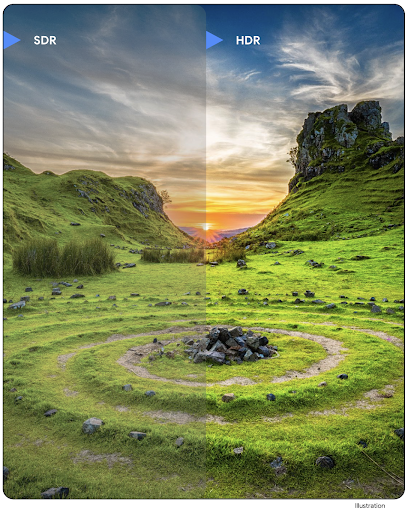
Android 14 adds support for High Dynamic Range (HDR) images that retain more of the information from the sensor when taking a photo, which enables vibrant colors and greater contrast. Android uses the Ultra HDR format, which is fully backward compatible with JPEG images, allowing apps to seamlessly interoperate with HDR images, displaying them in Standard Dynamic Range (SDR) as needed.
Rendering these images in the UI in HDR is done automatically by the framework
when your app opts in to using HDR UI for its Activity Window, either through a
manifest entry or at runtime by calling
Window.setColorMode(). You can also capture compressed Ultra
HDR still images on supported devices. With more colors recovered
from the sensor, editing in post can be more flexible. The
Gainmap associated with Ultra HDR images can be used to render
them using OpenGL or Vulkan.
Zoom, messa a fuoco, post-visualizzazione e altro ancora nelle estensioni della fotocamera
Android 14 upgrades and improves camera extensions, allowing apps to handle longer processing times, which enables improved images using compute-intensive algorithms like low-light photography on supported devices. These features give users an even more robust experience when using camera extension capabilities. Examples of these improvements include:
- Dynamic still capture processing latency estimation provides much more
accurate still capture latency estimates based on the current scene and
environment conditions. Call
CameraExtensionSession.getRealtimeStillCaptureLatency()to get aStillCaptureLatencyobject that has two latency estimation methods. ThegetCaptureLatency()method returns the estimated latency betweenonCaptureStartedandonCaptureProcessStarted(), and thegetProcessingLatency()method returns the estimated latency betweenonCaptureProcessStarted()and the final processed frame being available. - Support for capture progress callbacks so that apps can display the current
progress of long-running, still-capture processing operations. You can check
if this feature is available with
CameraExtensionCharacteristics.isCaptureProcessProgressAvailable, and if it is, you implement theonCaptureProcessProgressed()callback, which has the progress (from 0 to 100) passed in as a parameter. Extension specific metadata, such as
CaptureRequest.EXTENSION_STRENGTHfor dialing in the amount of an extension effect, such as the amount of background blur withEXTENSION_BOKEH.Postview Feature for Still Capture in camera extensions, which provides a less-processed image more quickly than the final image. If an extension has increased processing latency, a postview image could be provided as a placeholder to improve UX and switched out later for the final image. You can check if this feature is available with
CameraExtensionCharacteristics.isPostviewAvailable. Then you can pass anOutputConfigurationtoExtensionSessionConfiguration.setPostviewOutputConfiguration.Support for
SurfaceViewallowing for a more optimized and power-efficient preview render path.Support for tap to focus and zoom during extension usage.
Zoom nel sensore
Quando REQUEST_AVAILABLE_CAPABILITIES_STREAM_USE_CASE in
CameraCharacteristics contiene
SCALER_AVAILABLE_STREAM_USE_CASES_CROPPED_RAW, la tua app
puoi utilizzare le funzionalità avanzate del sensore per assegnare a uno stream RAW ritagliata gli stessi
pixel del campo visivo completo utilizzando un CaptureRequest
con un target RAW con il caso d'uso dello stream impostato su
CameraMetadata.SCALER_AVAILABLE_STREAM_USE_CASES_CROPPED_RAW.
Grazie all'implementazione dei controlli di override della richiesta, la videocamera aggiornata offre agli utenti il controllo dello zoom anche prima che gli altri controlli della videocamera siano pronti.
Audio USB lossless
Android 14 gains support for lossless audio formats for audiophile-level
experiences over USB wired headsets. You can query a USB device for its
preferred mixer attributes, register a listener for changes in preferred mixer
attributes, and configure mixer attributes using the
AudioMixerAttributes class. This class represents the
format, such as channel mask, sample rate, and behavior of the audio mixer. The
class allows for audio to be sent directly, without mixing,
volume adjustment, or processing effects.
Produttività e strumenti per gli sviluppatori
Gestore delle credenziali
Android 14 aggiunge Gestore delle credenziali come API di piattaforma, con un supporto aggiuntivo per i dispositivi con Android 4.4 (livello API 19) tramite una libreria Jetpack che utilizza Google Play Services. Lo scopo di Credential Manager è semplificare l'accesso degli utenti con API che recuperano e archiviano le credenziali con i fornitori di credenziali configurati dall'utente. Credential Manager supporta più metodi di accesso, tra cui nome utente e password, passkey e soluzioni di accesso federato (come Accedi con Google) in un'unica API.
Le passkey offrono molti vantaggi. Ad esempio, le passkey si basano sugli standard di settore, possono funzionare su diversi sistemi operativi ed ecosistemi dei browser e possono essere utilizzate sia su siti web sia su app.
Per ulteriori informazioni, consulta la documentazione di Gestore delle credenziali e delle passkey e il post del blog su Gestore delle credenziali e passkey.
Connessione Salute
Connessione Salute è un repository on-device per i dati relativi a salute e attività fisica degli utenti. Consente agli utenti di condividere dati tra le loro app preferite, con un unico punto di controllo per i dati che vogliono condividere con queste app.
Sui dispositivi con versioni precedenti ad Android 14, Health Connect è disponibile come app scaricabile dal Google Play Store. A partire da Android 14, Connessione Salute fa parte della piattaforma e riceve aggiornamenti tramite gli aggiornamenti di sistema Google Play senza richiedere un download separato. In questo modo, Connessione Salute può essere aggiornata di frequente e le tue app possono fare affidamento sulla disponibilità di Connessione Salute sui dispositivi con Android 14 o versioni successive. Gli utenti possono accedere a Connessione Salute dalle impostazioni del proprio dispositivo, con i controlli della privacy integrati nelle impostazioni di sistema.
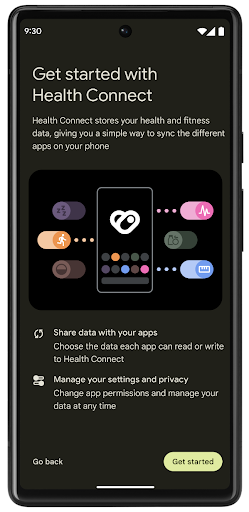

Connessione Salute include diverse nuove funzionalità in Android 14, come i percorsi di allenamento, che consentono agli utenti di condividere un percorso del loro allenamento che può essere visualizzato su una mappa. Un percorso è definito come un elenco di località salvate in un determinato periodo di tempo e la tua app può inserire percorsi nelle sessioni di allenamento, collegandoli tra loro. Per garantire che gli utenti abbiano il controllo completo su questi dati sensibili, devono consentire la condivisione di singoli percorsi con altre app.
Per ulteriori informazioni, consulta la documentazione di Connessione Salute e il post del blog sulle novità di Android Salute.
Aggiornamenti di OpenJDK 17
Android 14 continues the work of refreshing Android's core libraries to align with the features in the latest OpenJDK LTS releases, including both library updates and Java 17 language support for app and platform developers.
The following features and improvements are included:
- Updated approximately 300
java.baseclasses to Java 17 support. - Text Blocks, which introduce multi-line string literals to the Java programming language.
- Pattern Matching for instanceof, which allows an object to
be treated as having a specific type in an
instanceofwithout any additional variables. - Sealed classes, which allow you restrict which classes and interfaces can extend or implement them.
Thanks to Google Play system updates (Project Mainline), over 600 million devices are enabled to receive the latest Android Runtime (ART) updates that include these changes. This is part of our commitment to give apps a more consistent, secure environment across devices, and to deliver new features and capabilities to users independent of platform releases.
Java and OpenJDK are trademarks or registered trademarks of Oracle and/or its affiliates.
Miglioramenti per gli store
Android 14 introduces several PackageInstaller APIs that
allow app stores to improve their user experience.
Request install approval before downloading
Installing or updating an app might require user approval.
For example, when an installer making use of the
REQUEST_INSTALL_PACKAGES permission attempts to install a
new app. In prior Android versions, app stores can only request user approval
after APKs are written to the install session and the
session is committed.
Starting with Android 14, the requestUserPreapproval()
method lets installers request user approval before committing the install
session. This improvement lets an app store defer downloading any APKs until
after the installation has been approved by the user. Furthermore, once a user
has approved installation, the app store can download and install the app in the
background without interrupting the user.
Claim responsibility for future updates
The setRequestUpdateOwnership() method allows an installer
to indicate to the system that it intends to be responsible for future updates
to an app it is installing. This capability enables update ownership
enforcement, meaning that only the update owner is permitted
to install automatic updates to the app. Update ownership enforcement helps to
ensure that users receive updates only from the expected app store.
Any other installer, including those making use of the
INSTALL_PACKAGES permission, must receive explicit user
approval in order to install an update. If a user decides to proceed with an
update from another source, update ownership is lost.
Update apps at less-disruptive times
App stores typically want to avoid updating an app that is actively in use because this leads to the app's running processes being killed, which potentially interrupts what the user was doing.
Starting with Android 14, the InstallConstraints API
gives installers a way to ensure that their app updates happen at an opportune
moment. For example, an app store can call the
commitSessionAfterInstallConstraintsAreMet() method to
make sure that an update is only committed when the user is no longer
interacting with the app in question.
Seamlessly install optional splits
With split APKs, features of an app can be delivered in separate APK files,
rather than as a monolithic APK. Split APKs allow app stores to optimize the
delivery of different app components. For example, app stores might optimize
based on the properties of the target device. The
PackageInstaller API has supported splits since its
introduction in API level 22.
In Android 14, the setDontKillApp() method allows an
installer to indicate that the app's running processes shouldn't be killed when
new splits are installed. App stores can use this feature to seamlessly install
new features of an app while the user is using the app.
Bundle di metadati dell'app
A partire da Android 14, il programma di installazione del pacchetto Android ti consente di specificare i metadati dell'app, ad esempio le prassi di sicurezza dei dati, da includere nelle pagine dello store come Google Play.
Rilevare quando gli utenti acquisiscono screenshot del dispositivo
Per creare un'esperienza più standardizzata per il rilevamento degli screenshot, Android 14 introduce un'API di rilevamento degli screenshot che tutela la privacy. Questa API consente alle app di registrare i callback in base all'attività. Questi callback vengono richiamati e l'utente riceve una notifica quando acquisisce uno screenshot mentre l'attività è visibile.
Esperienza utente
Azioni personalizzate del foglio di condivisione e ranking migliorato
Android 14 aggiorna la scheda di condivisione di sistema per supportare azioni di app personalizzate e risultati di anteprima più informativi per gli utenti.
Aggiungere azioni personalizzate
Con Android 14, la tua app può aggiungere azioni personalizzate alla scheda di condivisione di sistema che richiama.

Migliorare il ranking dei target di condivisione diretta
Android 14 utilizza più indicatori delle app per determinare il ranking dei target di condivisione diretta al fine di fornire risultati più utili all'utente. Per fornire l'indicatore più utile per il ranking, segui le indicazioni per migliorare i ranking dei target di condivisione diretta. Le app di comunicazione possono anche segnalare l'utilizzo delle scorciatoie per i messaggi in uscita e in entrata.
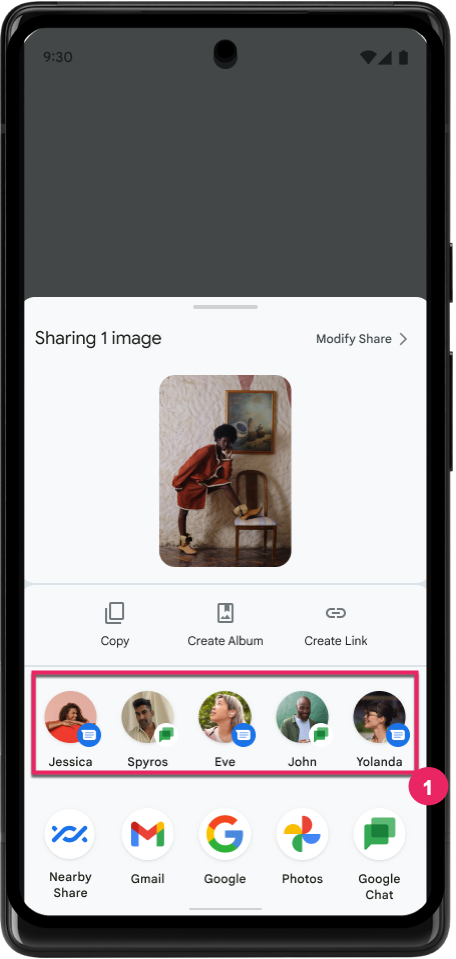
Supporto di animazioni integrate e personalizzate per il gesto Indietro predittivo
Android 13 ha introdotto l'animazione di ritorno alla schermata Home predittiva come opzione per gli sviluppatori. Se viene utilizzato in un'app supportata con l'opzione per gli sviluppatori attivata, lo scorrimento indietro mostra un'animazione che indica che il gesto di ritorno all'indietro fa uscire dall'app e torna alla schermata Home.
Android 14 include diversi miglioramenti e nuove indicazioni per il pulsante Indietro predittivo:
- Puoi impostare
android:enableOnBackInvokedCallback=trueper attivare le animazioni di sistema Indietro predittive per ogni attività anziché per l'intera app. - Abbiamo aggiunto nuove animazioni di sistema per accompagnare l'animazione di ritorno alla home page di Android 13. Le nuove animazioni di sistema sono interattive e inter-attività e vengono visualizzate automaticamente dopo la migrazione a Indietro predittivo.
- Abbiamo aggiunto nuove animazioni dei componenti Material per schede inferiori, schede laterali e Ricerca.
- Abbiamo creato linee guida per il design per la creazione di animazioni e transizioni in-app personalizzate.
- Abbiamo aggiunto nuove API per supportare le animazioni di transizione in-app personalizzate:
handleOnBackStarted,handleOnBackProgressed,handleOnBackCancelledinOnBackPressedCallbackonBackStarted,onBackProgressed,onBackCancelledinOnBackAnimationCallback- Utilizza
overrideActivityTransitionanzichéoverridePendingTransitionper le transizioni che rispondono quando l'utente scorri indietro.
Con questa release di anteprima di Android 14, tutte le funzionalità di Indietro predittivo rimangono nascoste dietro un'opzione per sviluppatori. Consulta la guida per gli sviluppatori per eseguire la migrazione della tua app al flusso di ritorno predittivo, nonché la guida per gli sviluppatori per creare transizioni in-app personalizzate.
Override per app del produttore di dispositivi con schermo grande
Per-app overrides enable device manufacturers to change the behavior of apps on large screen devices. For example, the FORCE_RESIZE_APP override instructs the system to resize the app to fit display dimensions (avoiding size compatibility mode) even if resizeableActivity="false" is set in the app manifest.
Overrides are intended to improve the user experience on large screens.
New manifest properties enable you to disable some device manufacturer overrides for your app.
Override per app per utenti con schermi di grandi dimensioni
Le sostituzioni per app modificano il comportamento delle app sui dispositivi con schermi grandi. Ad esempio, l'override del produttore del dispositivo OVERRIDE_MIN_ASPECT_RATIO_LARGE imposta le proporzioni dell'app su 16:9 indipendentemente dalla configurazione dell'app.
Android 14 QPR1 consente agli utenti di applicare sostituzioni per app tramite un nuovo menu delle impostazioni sui dispositivi con schermi di grandi dimensioni.
Condivisione della schermata dell'app
App screen sharing enables users to share an app window instead of the entire device screen during screen content recording.
With app screen sharing, the status bar, navigation bar, notifications, and other system UI elements are excluded from the shared display. Only the content of the selected app is shared.
App screen sharing improves productivity and privacy by enabling users to run multiple apps but limit content sharing to a single app.
Risposta rapida basata su LLM in Gboard su Pixel 8 Pro
On Pixel 8 Pro devices with the December Feature Drop, developers can try out higher-quality smart replies in Gboard powered by on-device Large Language Models (LLMs) running on Google Tensor.
This feature is available as a limited preview for US English in WhatsApp, Line, and KakaoTalk. It requires using a Pixel 8 Pro device with Gboard as your keyboard.
To try it out, first enable the feature in Settings > Developer Options > AiCore Settings > Enable Aicore Persistent.
Next, open a conversation in a supported app to see LLM-powered Smart Reply in Gboard's suggestion strip in response to incoming messages.
Grafica
I percorsi sono interrogabili e interpolabili
L'API Path di Android è un meccanismo potente e flessibile per la creazione e il rendering di grafica vettoriale. Consente di tracciare o riempire un percorso, di creare un percorso da segmenti di linea o di curve quadratiche o cubiche, eseguire operazioni booleane per ottenere forme ancora più complesse o tutte contemporaneamente. Un limite è la capacità di scoprire cosa si trova effettivamente in un
oggetto Path. I componenti interni dell'oggetto sono opachi per i chiamanti dopo la creazione.
Per creare un Path, chiami metodi come
moveTo(), lineTo() e
cubicTo() per aggiungere segmenti di percorso. Tuttavia, non è stato possibile chiedere a quel percorso quali sono i segmenti, quindi devi conservare queste informazioni al momento della creazione.
A partire da Android 14, puoi eseguire query sui percorsi per scoprire i contenuti al loro interno.
Innanzitutto, devi ottenere un oggetto PathIterator utilizzando l'API
Path.getPathIterator:
Kotlin
val path = Path().apply { moveTo(1.0f, 1.0f) lineTo(2.0f, 2.0f) close() } val pathIterator = path.pathIterator
Java
Path path = new Path(); path.moveTo(1.0F, 1.0F); path.lineTo(2.0F, 2.0F); path.close(); PathIterator pathIterator = path.getPathIterator();
Successivamente, puoi chiamare PathIterator per ripetere i segmenti uno alla volta, recuperando tutti i dati necessari per ciascun segmento. Questo esempio utilizza oggetti PathIterator.Segment, che pacchettizzano i dati per te:
Kotlin
for (segment in pathIterator) { println("segment: ${segment.verb}, ${segment.points}") }
Java
while (pathIterator.hasNext()) { PathIterator.Segment segment = pathIterator.next(); Log.i(LOG_TAG, "segment: " + segment.getVerb() + ", " + segment.getPoints()); }
PathIterator ha anche una versione non allocabile di next() in cui puoi passare
in un buffer per contenere i dati dei punti.
Uno dei casi d'uso importanti dell'esecuzione di query sui dati di Path è l'interpolazione. Ad esempio, potresti voler creare un'animazione (o morph) tra due percorsi diversi. Per
semplificare ulteriormente questo caso d'uso, Android 14 include anche il
metodo interpolate() su Path. Supponendo che i due percorsi abbiano la stessa struttura interna, il metodo interpolate() crea un nuovo Path con il risultato interpolato. Questo esempio restituisce un percorso la cui forma è intermedia (un'interpolazione lineare di 0,5) tra path e otherPath:
Kotlin
val interpolatedResult = Path() if (path.isInterpolatable(otherPath)) { path.interpolate(otherPath, .5f, interpolatedResult) }
Java
Path interpolatedResult = new Path(); if (path.isInterpolatable(otherPath)) { path.interpolate(otherPath, 0.5F, interpolatedResult); }
La libreria graphics-path di Jetpack abilita API simili anche per le versioni precedenti di Android.
Mesh personalizzate con shader di vertici e frammenti
Android supporta da tempo il disegno di mesh triangolari con ombreggiatura personalizzata, ma il formato della mesh di input è stato limitato a poche combinazioni di attributi predefinite. Android 14 aggiunge il supporto per le matrici personalizzate, che possono essere definite come triangoli o strisce di triangoli, e possono, facoltativamente, essere indicizzate. Questi mesh sono specificati con attributi personalizzati, passi di vertice, variabili e shader di vertici e frammenti scritti in AGSL.
Lo shader vertex definisce le varianti, come posizione e colore, mentre lo shader fragment può facoltativamente definire il colore del pixel, in genere utilizzando le varianti create dallo shader vertex. Se il colore viene fornito dall'shader frammento, viene mischiato con il colore Paint corrente utilizzando la modalità di miscela selezionata durante il disegno del mesh. Le uniformi possono essere passate agli shader di frammento e vertice per una maggiore flessibilità.
Renderer del buffer hardware per Canvas
Per facilitare l'utilizzo dell'API Canvas di Android per disegnare con accelerazione hardware in un HardwareBuffer, Android 14 introduce HardwareBufferRenderer. Questa API è particolarmente utile quando il caso d'uso prevede la comunicazione con il compositore di sistema tramite SurfaceControl per il disegno con bassa latenza.

